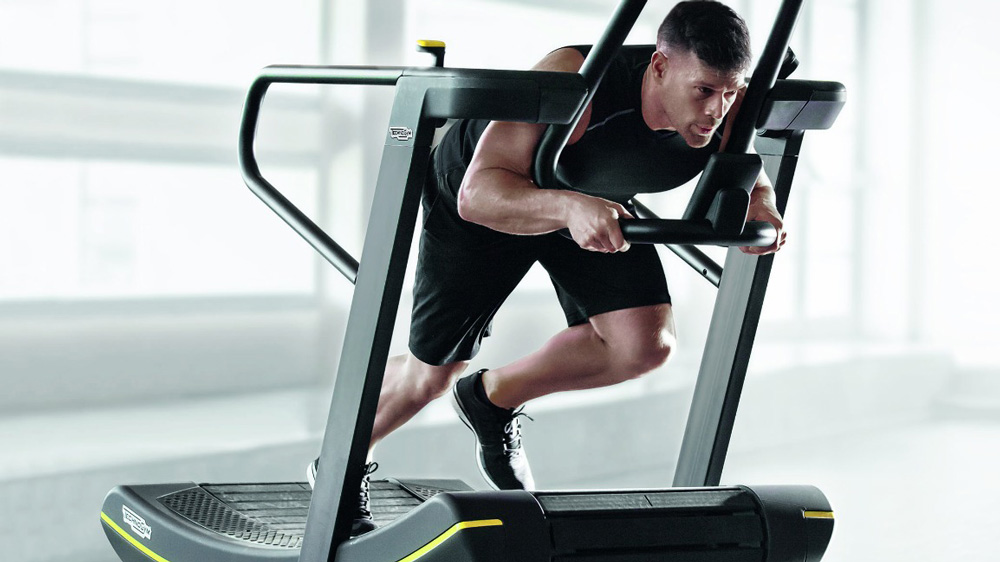Sharpen Up Your Speed, Strength And Stamina With This 15-Minute SkillMill Treadmill Workout
Needless to say, it’s going to be a very tough 15 minutes

The self-powered treadmill is one the best pieces of gym equipment that you’re currently not using (probably). The main advantage of a non-motorised deck is that you can up the pace instantly, rather than holding down a button and waiting for the speed to slowly increase.
This makes self-powered treadmills great for short, sharp HIIT sessions in particular, and some non-motorised treadmills also have the option to increase the resistance on the belt, so you can do exercises like sled pushes to strengthen your legs.
If your gym has a Technogym SkillMill, you can put your legs through their paces in just 15 minutes by trying this workout created by Technogym master trainer Rory Knight.
15-Minute SkillMill Treadmill Workout
“If you’re a beginner who has never used a Technogym SkillMill before, ensure you hold the side rails – only free your arms up when you have a feel for the machine and feel comfortable to let go,” says Knight. “The first few minutes are all about building confidence.”
Even with a quick 15-minute blast on the SkillMill, it’s important to warm up. Going straight into sprints is a recipe for injury disaster.
“I love to start with a few simple but highly effective agility drills in all my SkillMill workouts,” says Knight, “particularly to prime the hamstrings and calves.”
Warm-Up
Start with 30sec of brisk walking before easing into a light jog for 1min 30sec, performing the two drills below during that time.
Sign up for workout ideas, training advice, reviews of the latest gear and more.
“While jogging, rapidly kick your heels back behind you towards your butt repeatedly for 15 seconds,” says Knight. “This is a classic drill to ensure that your hamstrings are super warm and fired up before progressing onto speed work.”
The second drill to include in your warm up is skipping.
“With your skips you want to drive off the front of each foot in order to prepare for more explosive action later in the workout,” says Knight. “If you struggle with either of these drills, focus on pinpointing your weaknesses and work on them until they become your strengths.”
“Gradually pick up your pace two minutes into the warm-up for another two minutes, focusing on correct running mechanics with a chest up, shoulders down posture. Try to remain nice and light on your feet, minimising ground contact time by imagining that the SkillMill deck is red-hot underfoot.”
“Remember your warm-up is where you set the tone for the rest of your workout, with form and posture a crucial component of your running.”
Section 1 – Conditioning and stamina
For this section you will do two rounds of three exercises. Don’t rest between exercises, and be careful not to overdo it on round one.
“Be aware of the cumulative effect of this block – be cautious with your speed and effort on the first round and begin to ramp up the intensity on round two,” says Knight.
Squat
Time 30sec
“Stand on the sides of the SkillMill and perform squats for 30sec,” says Knight. “Control your descent, taking 2-3sec on the way down and sitting back into your heels. Just before you drive up, your head should be facing forwards, with your arms in front of you for balance. Take 1-2sec to drive up tall and strong, squeezing your glutes at the very top.”
Run
Time 30sec
“You should be pushing at around 75-80% of your maximum effort,” says Knight.
Sled push
Time 30sec
Lean your body into the SkillMill and grab the handles beneath the console.
“Crank the resistance up to between levels 8 and 10,” says Knight. “Get low, lift your knees, keep your heels lifted and fully extend your leg back, really focusing on using the powerhouse of your body – your glutes.”
After completing two rounds of the above without rest, do a 30sec light walk for active recovery, then continue to the next section.
Section 2 – Acceleration intervals
This section of the workout involves two 90sec progression runs. Do these back-to-back, only resting after you’ve completed both.
“Keeping the SkillMill resistance set to 0, build your speed from 30sec at an easy level (up to 50% effort), to 30sec at a slightly uncomfortable pace (65-75% effort level), and then 30sec of high-intensity, hard effort (80-90%),” says Knight.
“Ensure there is a distinct contrast between each phase and create the need to take the active recovery, which is the easy phase.”
After your two progression runs, walk slowly for 30sec as active recovery.
Section 3 – Speed
For a big finish, really open up your legs and hit your top speed.
“Sprint for 15sec at maximum effort, then run slowly for a 15sec recovery, then finish with another 15sec sprint where you completely empty the tank,” says Knight.
Warm-Down
“Remember to bring your heart rate down with some slow walking or jogging afterwards, and warm down with a combination of dynamic and static stretches, and ideally some foam rolling,” says Knight.

Nick Harris-Fry is a journalist who has been covering health and fitness since 2015. Nick is an avid runner, covering 70-110km a week, which gives him ample opportunity to test a wide range of running shoes and running gear. He is also the chief tester for fitness trackers and running watches, treadmills and exercise bikes, and workout headphones.
